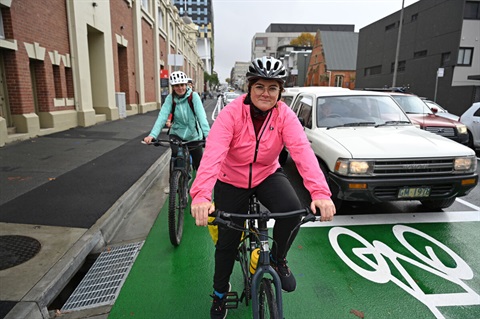
The City of Hobart has installed its first separated cycleways within the city centre, promoting safe and sustainable transport in the capital.
The lanes can be found along Campbell Street between Brisbane and Davey Street and are positioned between the kerb and parking areas with dedicated traffic signals for safety.
The bicycle lanes are part of the City's commitment to fostering a safe, accessible, and interconnected urban environment.
The $1.725 million project was equally funded under the Australian Government's Road Safety Program and the Tasmanian Government's Vulnerable Road User grants.
The decision to implement separated bicycle lanes follows extensive consultation with stakeholders, including adjacent property owners, businesses, and key organisations such as the University of Tasmania, Royal Automobile Club of Tasmania, and Tasmanian Bus Association.
The project also aligns with the Greater Hobart Cycling Plan, a key initiative of the Hobart City Deal and the Greater Hobart Transport Vision.
As part of the project's commitment to ongoing evaluation and community engagement, feedback will be sought from the public through an online feedback form following the opening of the lanes.
After 12 months of operation, a full evaluation will be conducted, and recommendations for potential adjustments will be presented to the Council.
Similar separated bicycle lanes for Argyle Street and Bathurst Street are also nearly completed and will be open to the public in early June 2024.
Quotes attributable to Hobart Lord Mayor Anna Reynolds:
"Transport is the fastest growing source of climate change pollution in Australia and is projected to be the biggest source by 2030. Our cars and light commercial vehicles are the main contributor to this pollution.
"To tackle climate change it's not enough to wait for our cars to transition to electric.
"We also need to see many more of our journeys happening via public transport or in an active way, such as walking or by bike riding.
"As managers of the majority of the nation's streets, it's up to Councils to help this transition by making safe places for people to ride bikes and other two wheeled vehicles.
"Moving to zero-emissions vehicles and providing the infrastructure for more active transport journeys will result in safer street, cleaner air and reduced pollution.
"So many Australian capital cities and state governments are investing in connected and safe pathways for bikes to be separated from cars and trucks.
"Hobart joins Melbourne, Sydney, Adelaide, Brisbane, Canberra, Perth, Geelong, Bendigo, Wollongong and Newcastle with separated bike lanes.
"It's really becoming essential city infrastructure and so Hobart needs to ensure its keeping up with this trend of modernising our city streets for all users."
Quotes attributable to Hobart City Mobility Portfolio Chair Cr Ryan Posselt:
"The introduction of separated bicycle lanes is a proactive step towards enhancing road safety and promoting active transportation in our city.
"These lanes will serve as vital connections, seamlessly linking existing bicycle infrastructure and key destinations within Hobart."
Quotes attributable to Bicycle Network Public Affairs Manager Tasmania Alison Hetherington:
"I welcome the introduction of separated cycleways, emphasising their role in promoting cycling as a viable mode of transportation.
"The separated cycleway on Campbell Street is a crucial step in establishing a network that encourages more people to choose cycling or scooting as a mode of transport.
"By providing physical separation from moving traffic, these lanes instil confidence in cyclists and help create a safer and more inviting urban environment."






